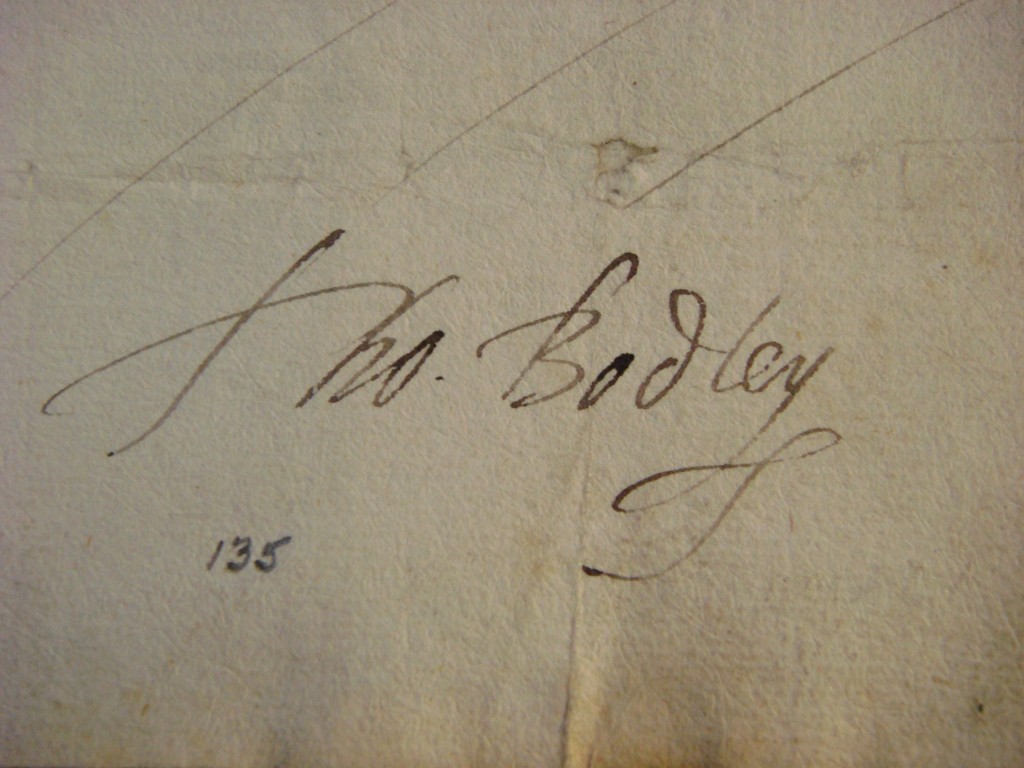
*This is the first in a series of 6 posts from Dr Robyn Adams, one the recipients of the [DM2E Open Humanities Awards](http://openhumanitiesawards.org).*
[This project](http://www.livesandletters.ac.uk/bodley/bodley.html) focuses on the people and places mentioned in the bundle of the c.1000 letters which survives from the embassy of Thomas Bodley to the Low Countries in the 1580s and 1590s. With the assistance of the Open Humanities Award, the project team will use the open data from the corpus of diplomatic correspondence to produce data visualizations.
[Thomas Bodley](http://www.livesandletters.ac.uk/bodley/biography.html) was a scholar and a diplomat, sent to negotiate England’s interests in aiding the Dutch in the war against Spain. Based in The Hague for around ten years, on and off, hundreds of his letters exist in the archives from this period which document the military, political and diplomatic activity of the time. Bodley was in correspondence with [Queen Elizabeth I](http://www.bbc.co.uk/history/people/elizabeth_I) and the major politicians of the period back home at the English court, and was required to keep them up to date with fresh news, intelligence and reports about various aspects of the war. [The letters are crammed full of interesting information](http://cell.livesandletters.ac.uk/Bodley/transcript.php?fname=xml//1589//DCB_0805.xml), ranging from the complicated [dynastic marriage negotiations](http://cell.livesandletters.ac.uk/Bodley/transcript.php?fname=xml//1592//DCB_1110.xml) of the major ruling families of the numerous provinces of the Low Countries, to the [secret nocturnal movements of troops](http://cell.livesandletters.ac.uk/Bodley/transcript.php?fname=xml//1592//DCB_0396.xml). This diverse information offers a rich context in which to read the diplomatic manoeuvres and negotiations with which Bodley was occupied. (It also seems he was sent on an errand by Sir [Francis Walsingham](http://en.wikipedia.org/wiki/Francis_Walsingham) Queen Elizabeth’s chief intelligence officer – a data wrangler of his own time – to [search the Amsterdam area for joints of gammon to send back to England)]( http://cell.livesandletters.ac.uk/Bodley/transcript.php?fname=xml//1585//DCB_0612.xml).
In the early stages of the project, I (as principal investigator and editor of the letters) decided to encode ‘extra’ information that I knew would be valuable, even though I wasn’t quite sure how it would be used. This extra information included complex and extensive lists of people and places mentioned in the letters. This information was not always easy to rationalize in the sense of working out to whom or where Bodley was referring in his letters. In [one letter he wrote to his recipient that the Duke of Brunswick’s](https://en.wikipedia.org/wiki/Julius,_Duke_of_Brunswick-L%C3%BCneburg) eldest son would be married to the [Duke of Saxony’s](http://en.wikipedia.org/wiki/Augustus,_Elector_of_Saxony) second eldest daughter. It took some avid sleuthing through the family trees of the northern European sovereign states in the early modern period to work out that Heinrich Julius, son of the [Duke of Brunswick](https://en.wikipedia.org/wiki/Henry_Julius,_Duke_of_Brunswick-L%C3%BCneburg) was going to marry [Dorothea, second daughter of Augustus, Duke of Saxony](http://cell.livesandletters.ac.uk/Bodley/transcript.php?fname=xml//1585//DCB_0080.xml).
Because the spelling of the period is extremely odd to the modern eye, which makes searching for specific words difficult, I figured that tagging this extra data in the XML transcripts would offer an alternative entry route to the corpus of letters for browsing, and at the same time offer scholars outside my own immediate academic constituency (history, English literature, textual and archive studies) the opportunity to wrangle the project’s data sets. I figured that someone, somewhere might be interested in these elements, and it would be worthwhile to tag them. Moreover, in the current economic academic climate it is unlikely that another scholar will edit the letters electronically, so I thought it worth the added labour. I also tried to envisage and anticipate which elements from the corpus would interest and attract scholars in other fields. I knew it was desirable for a digital edition to be able to speak to other communities, and contain data and information that could be extracted for varied purposes. As far as I could, with the limited resources to hand (the project team consisted of three persons, two of whom were part-time on the project), I attempted to ‘future-proof’ the edition by tagging as much data as I could. The result: two extremely long lists of names of people and places which offer a standard entry route to the corpus of correspondence, but which (more excitingly) offer a starting point to make some extremely tantalizing data visualizations.
As part of the Open Humanities Award, I now intend to behave as a new user of this data. The rich lists of people and places previously tagged in the body of the project offer an ideal chunk of data from which to wrangle and generate visualizations. We propose to use the open source software [Gephi](https://gephi.org/) to generate these visualizations, and I am really looking forward to seeing if new patterns for study emerge.
The project data is on [Github](https://github.com/livesandletters). The tags were indexed as [biographical](http://cell.livesandletters.ac.uk/Bodley/index.php?option=person) and [geographical](http://cell.livesandletters.ac.uk/Bodley/index.php?option=place) lists.
It is clear from his later correspondence and bibliographical activity that Bodley’s networks of friends and acquaintances established across northern Europe – almost certainly during this period – assisted in the creation of one of the oldest research libraries in the world, [the Bodleian Library at the University of Oxford](http://www.bodleian.ox.ac.uk/bodley). The visualizations, which will have scope to be playful while drawn from scrupulous scholarship, will offer an alternative pathway for scholars and the interested public to understand that in this period especially, the political, university and kinship networks were fundamental to advancement and prosperity. I propose to plumb the data already stored within the project to open the aperture wider, to try and understand Bodley’s place within the European network of agents, diplomats, military personnel and intelligencers. In mapping the relational activity between data sets, I hope to further illuminate and reanimate Bodley’s position within the Elizabethan compass and beyond.
We are hiring! CELL is seeking a Research Assistant to help with the data visualizations in this project. If you are interested in applying for this post (fixed term contract), please go [here for more information on the vacancy](http://tinyurl.com/nldt6rp).
Dr Robyn Adams is the Senior Research Fellow at the Centre for Editing Lives and Letters at UCL. Her work has led her from [tantalizing spy letters](http://www.livesandletters.ac.uk/projects/letters-william-herle) of the sixteenth century, through heavy diplomatic corpora to epic enumerative bibliography of the early records of the Bodleian Library.

Comments are closed.